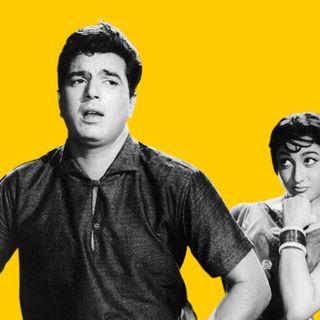
How the ‘Pan‑India’ Movie Phenomenon Embodies — And Redefines — Toxic Masculinity
The trailer of ‘Liger’, pegged as the next “pan Indian” film shares a common theme with the others: revved up hero-worship, angry masculinity, and all the makings of a cult-following.

When Baahubali: The Beginning (2015) released more than half a decade ago, it started something that has come to become the mainstay of how movies are made now. The film, released in multiple-languages, showed how it was possible to dissolve cultural barriers in moviemaking, by telling stories that bring all of India together (seemingly). The rise of “pan-Indian” films since Baahubali, then, is said to be driven by this idea: that there’s no longer such a thing as Hindi, Telugu, or Tamil films. But there’s a missing piece to the success formula of pan-Indian films that’s hidden in plain sight: a resurgence of hypermasculinity.
Many of the most recent films touted as “pan-Indian” have this in common. Their posters include beefed-up men looming large, often with an angry, menacing look on their faces and intimidating weapons in their hands. In RRR‘s poster, the two male leads are frozen, mid-roar, with one’s horse and the other’s motorbike partially lifted off the ground. The first looks of each character, moreover, showed one facing off with a tiger’s open jaws, and the other nocking an arrow on a bow. KGF features actor Yash wielding a hammer, seemingly his weapon of choice. Brahmastra features Ranbir Kapoor armed with a trishul, or a trident most commonly associated with the Hindu deity Shiva. And Pushpa: The Rise, features Allu Arjun with an ax.
In all of these, the aesthetic is rugged, urgent, and gruff: depicting brooding men in a crisis, rippling with strength and power in an undercurrent of palpable rage. It appears as if the “angry young man” archetype is back — but where the trope used to direct the anger at societal injustice (with Amitabh Bachchan in Sholay as the quintessential AYM), it is now the default setting.
Related on The Swaddle:
How OTT Films Perpetuate an Upper Class, Caste Aesthetic for the Social Media Generation
Women are once again reduced to mere props whose lives are only relevant insofar as they further the man’s character arc. Film critic Anna M. Vetticad noted this with regards to Pushpa: “…in an India torn apart by religious bigotry, language chauvinism and caste, potential uniting factors include misogyny, patriarchy, crass female objectification and a desire to control/own women.”
The masculinity gets so toxic, however, that, pan-Indian movies almost flip — or rather, extend — the idea of objectification that is typically attributed to women. Feminist film scholar Laura Mulvey famously defined the male gaze in cinema as one wherein men do the looking, and women are meant to be looked at. In pan-Indian cinema, a strange thing occurs: men do the look, and they’re also the ones looked at. In most — if not all — of the pan-Indian movies that have come out, or have released a “first look,” so far, men strike poses that are meant to captivate other men.
There’s a rawness to their sex appeal that almost isn’t even meant for anyone but other men to appreciate. This, coupled with the fact that there’s almost a homoerotic charge at play: cameras treat the male body with reverential awe, with fight scenes choreographed to make the men involved give vent to their repressed emotions through almost passionate wrestling. RRR was recently known for just this; Pushpa‘s climactic showdown between the hero and the villain had them both (inexplicably) strip down to their underwear and lock eyes with one another with unwavering intensity.
In Baahubali too, Prabhas’ hero hurtles into a death embrace with Rana Daggubati’s equally buff villain in one of the longest fight sequences in recent times. Throughout these films, male heroes constantly have only one other person on their minds: male villains, and vice-versa. They’re equally matched, muscle-for-muscle, in lock-step with each other’s emotional beats. These are excessively physical movies, embodying the kind of masculinity that’s toxic, but also intoxicating — to other men.
Related on The Swaddle:
How Bollywood Is Losing Its Credibility
Many critics have noted how the success of pan-Indian movies isn’t rooted in resorting to any kind of lowest-common–denominator like one might think: in fact, the regional specificity of the films makes them sell, according to Rohan Sippy. Indeed, the stories and the people involved being predominantly from the Southern states has, as some observers note, created considerable churn across film industries in the country, particularly Bollywood.
The moment of Southern reckoning in the movies also comes at a time when debates around Hindi imposition have begun to peak, with actors themselves fighting over the relevance of the Hindi language in films.
But these films are arguably able to sell themselves to a “pan-Indian” audience by using their aesthetic of hypermasculinity as a vehicle — this being a language that everyone understands on a spiritual level. It’s why many have developed a cult following in their own right, with hero-worshipping tendencies amped up by many degrees. The phenomenon then prompts the question of whether the very idea of the scale itself is masculine. Can the rage of women ever be “larger than life,” and is that a desirable goal? Arguably not — if scale, size, and strength are the hallmarks of pan-Indian cinema, they are not only beholden, but inextricable from toxic masculinity.
Rohitha Naraharisetty is a Senior Associate Editor at The Swaddle. She writes about the intersection of gender, caste, social movements, and pop culture. She can be found on Instagram at @rohitha_97 or on Twitter at @romimacaronii.
Related


Woe Is Me! “I’m Tired of My Friend’s Constant Sulking. How Do I Deal With His Pity Party?”
